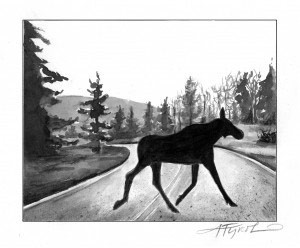
Why did the animal cross the road?
The yellow sign, familiar to many, proclaims “Moose Crossing.” But, we wonder, how can anyone predict that a moose would cross at this particular spot, among miles of similar-looking road on either side?
Surprisingly, an animal crossing a road is rarely an arbitrary event. And to understand why road crossings deserve our attention, we should first appreciate that rural land in the Northeast is more fragmented by roads than in any other part of the U.S.
In this era of rural development, deer, skunks, raccoons, and red foxes that are adapted to forest edges have increased along with the numbers of house clearings. These are the animals we see most frequently, since they are seldom found more than half a mile or so from human habitation. Foxes, skunks, and raccoons will eat almost anything, including garbage. In New Hampshire and Vermont, the territory of a fox is about 4 square miles, and a raccoon’s is 1 to 3 square miles.
In contrast to these familiar animals, there are other species that are adapted to large tracts of forest and shun human presence. As development and roads push into formerly wild areas, these animals suffer from a reduction in habitat. Such animals include black bear, bobcat, fisher, and moose. These species require many square miles per individual to meet their needs because they range widely in search of seasonally abundant food sources.
For instance, bears in spring eat the growing tips of wetland vegetation, but by mid-summer, they are seeking upland berries and seeds. In fall, they fatten up on beech nuts and acorns in preparation for the rigors of hibernation. Moose also travel widely, feeding in summer on vegetation in and around wetlands and in winter up in the protection of mountainside coniferous forest. To give some idea of the magnitude of their movements, a male bear’s territory may cover 50 square miles and a male bobcat’s up to 60 square miles. A moose, meanwhile, may travel 60 miles between summer and winter habitat.
Regardless of whether animals require a large or small range, the fragmented nature of their habitats means they are forced to cross roads in order to survive. Deer, foxes, skunks, and raccoons are often seen on roads as they move around locally, whereas moose, bear, and bobcats tend to cross more seasonally.
When crossing roads, wildlife prefer places where there is a good cover of trees and shrubs on either side of the road. Since animals typically travel along rivers and streams, they frequently cross roads near culverts and bridges. Animals also follow ridge lines and thus are likely to be found crossing at the height of land. Guard rails and impassable roadside ledges are among obstacles that hinder crossing, particularly of inexperienced animals that have recently left their mothers to find a territory of their own. In fact, the fall season, when young animals disperse, is grimly known as “road kill season” for its peak number of animal collisions.
A habitual road-crossing site often provides a clue to the route traditionally taken by animals as they move from one habitat area to another. These established routes are referred to as wildlife corridors. Protection of these corridors is crucial to maintaining our wildlife species. If habitat areas become isolated “islands” cut off from each other by human development, the genetic legacy of the animals corralled within each island will slowly degenerate due to inbreeding. If a species within an island is wiped out by disease or a hard winter, this habitat will not be repopulated because new animals have no way to reach it. Young animals also have no way to disperse to establish their own home territories, resulting in mortality due to competition for food.
If animals are to move freely about the landscape, we humans need to keep habitat areas connected with swaths of natural vegetation. How wide should these protected corridors be? The general rule is that wider is always better, but minimum size depends on geographic scale. Regional corridors that connect large blocks of habitat along ecological gradients, such as from coast to inland, should be substantial, over a third of a mile in width. Sub-regional corridors, for instance a connection between mountain slope and valley bottom, should aim for at least a quarter-mile of width. Local corridors, connecting smaller habitat fragments for smaller animals, can function with as little as 50 yards of width.
The preservation of wildlife corridors is of utmost importance to the health of many of our wildlife species. If we don’t figure out where to put those “moose crossing” signs, and how to protect the corridors leading up to them, we’ll put some of our most treasured species – including ourselves as drivers – at increased risk.

